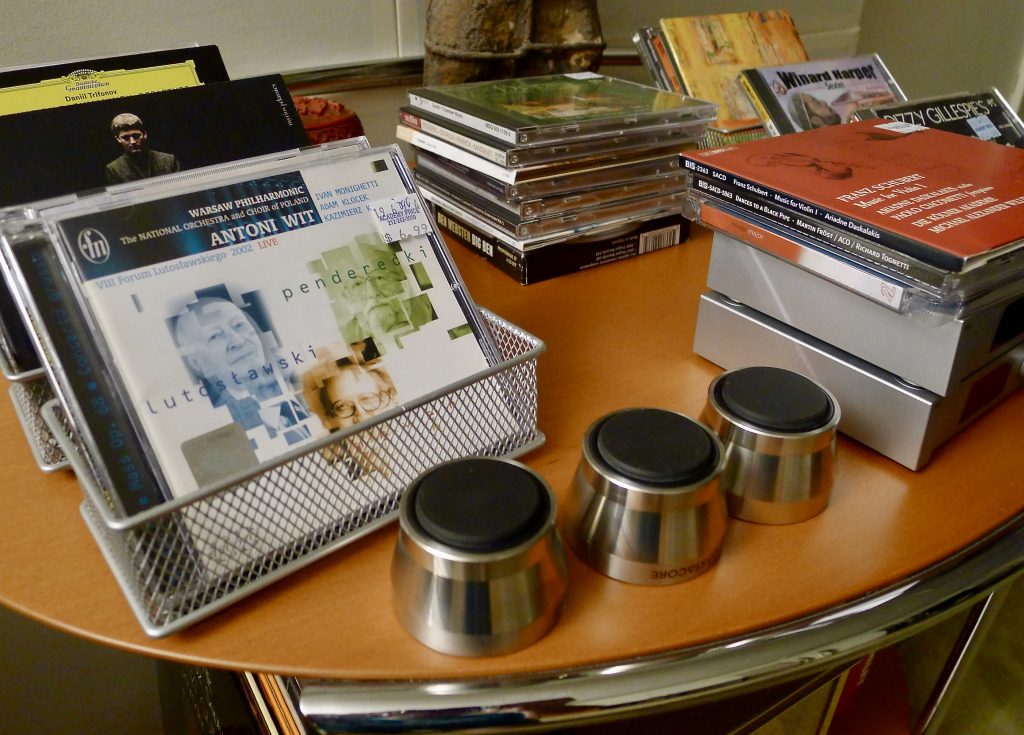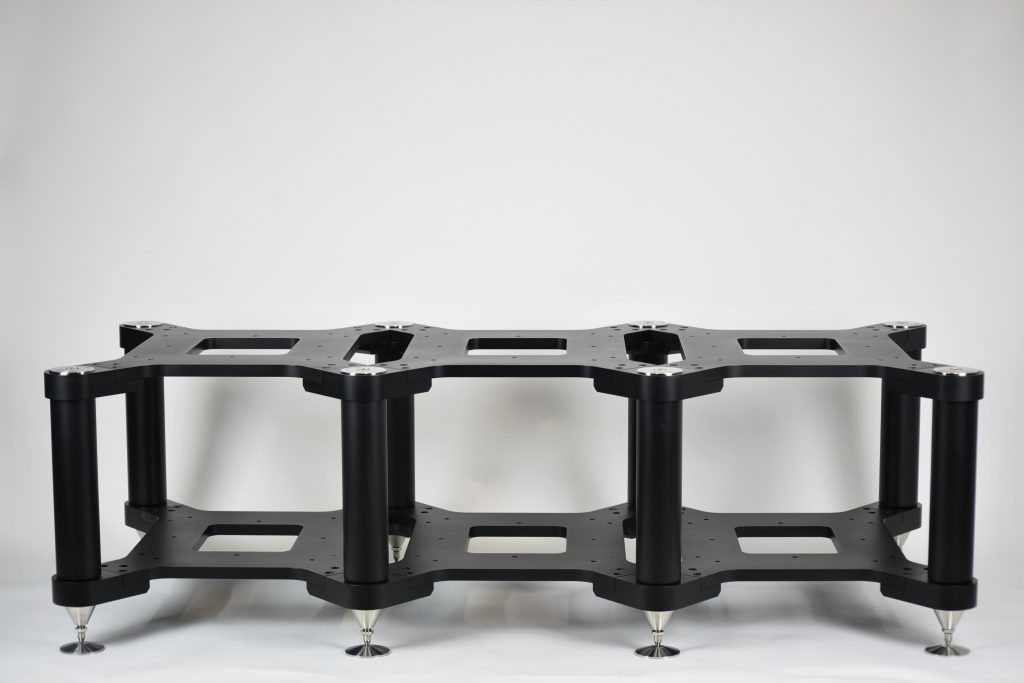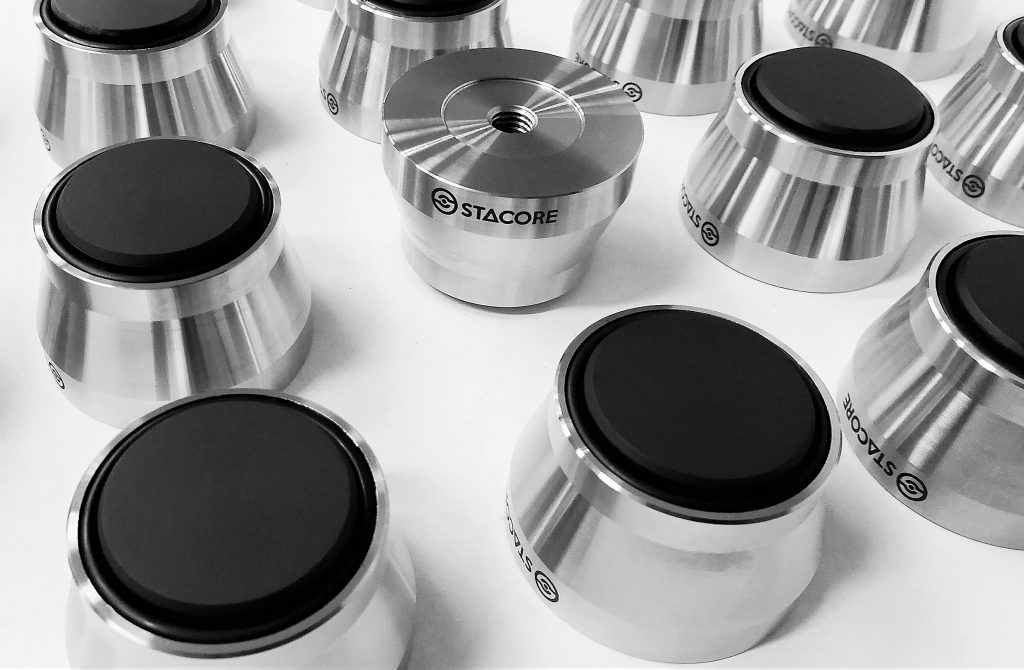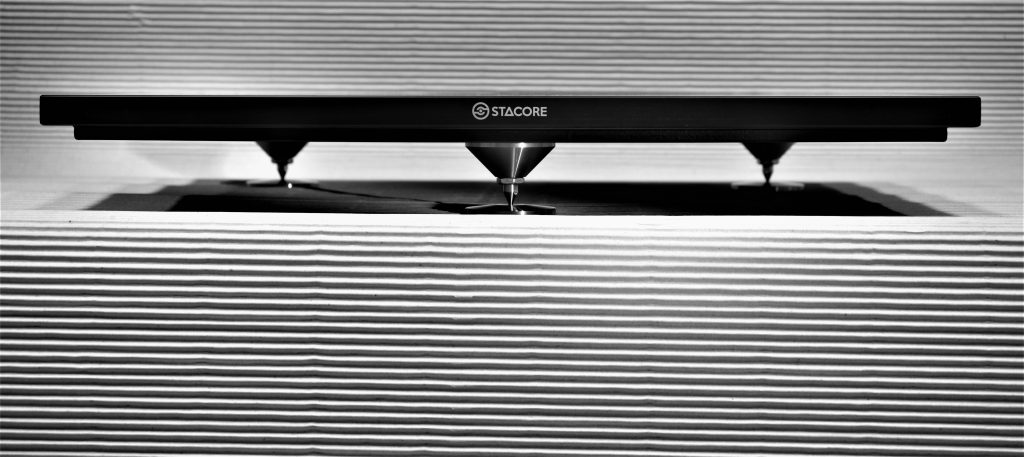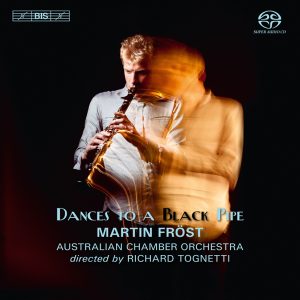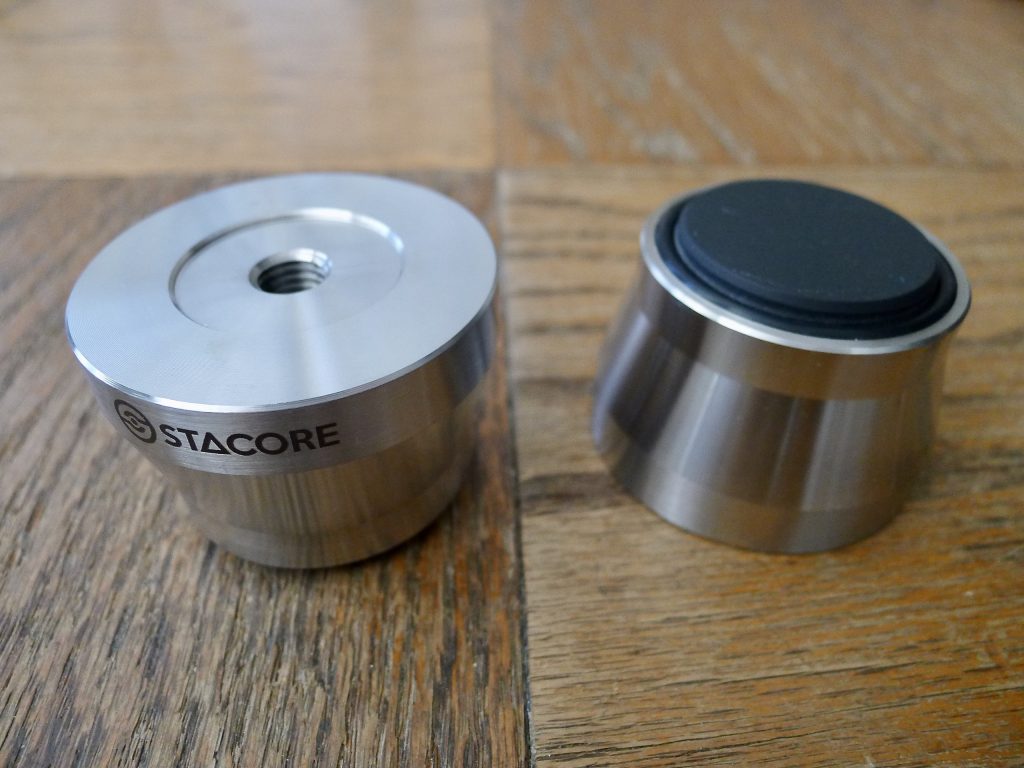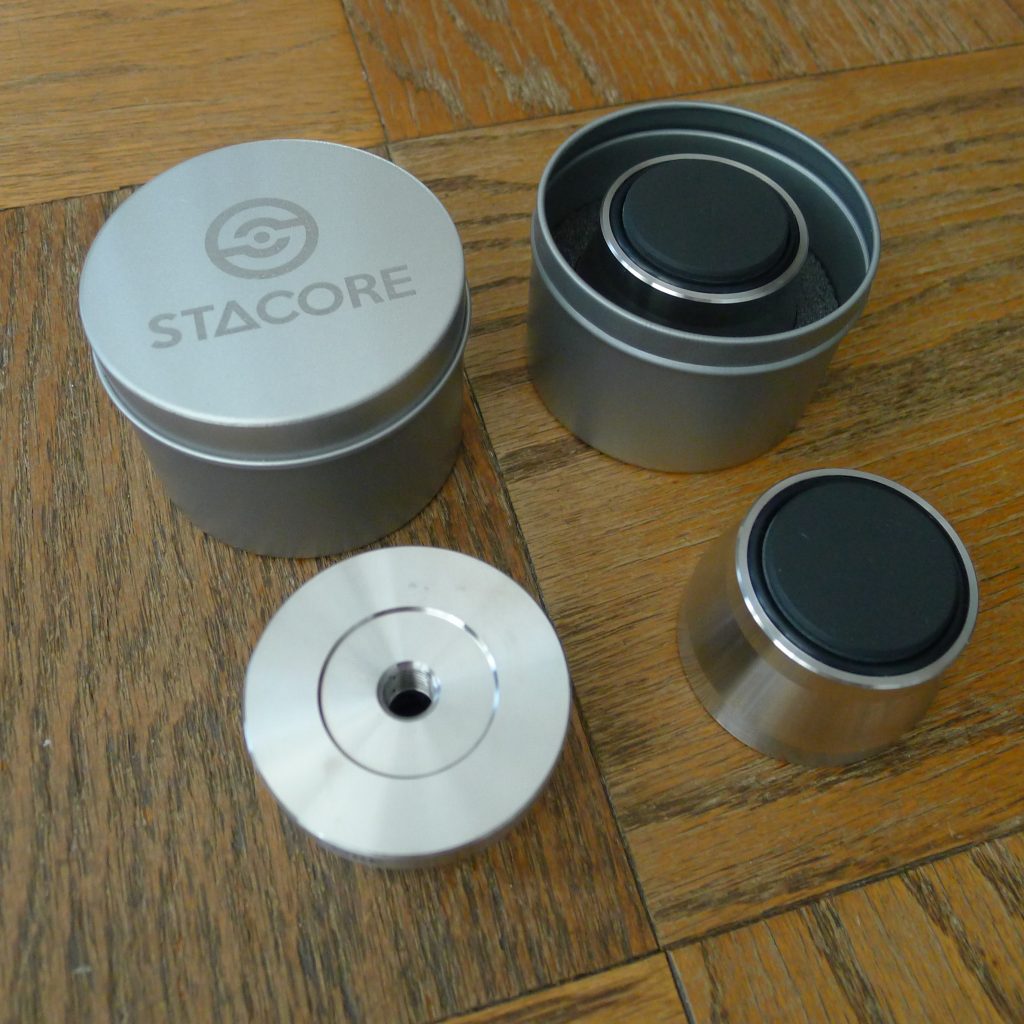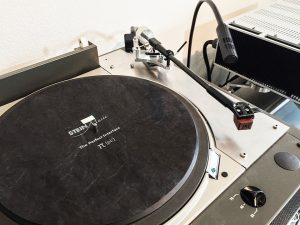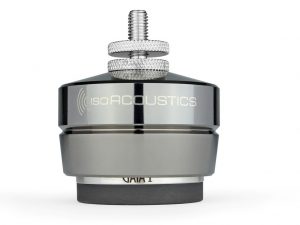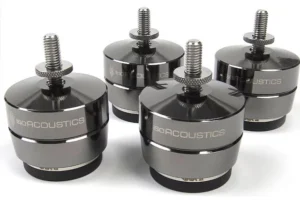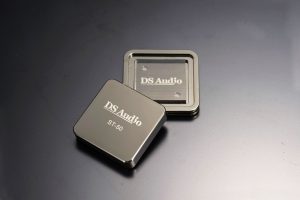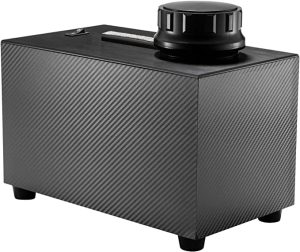In the beginning I was the tweakaholic. I spent much time fooling around with and writing about all manner of audio accessories, searching for the sonic Band-Aid that would repair my sound. It wasn't what I wanted—actually, I wasn't sure what I wanted—and these devices always delivered something. I wore the moniker like a badge of honor. In retrospect, I have mixed feelings about it. At any rate, those days are long gone.
As my experience lengthened, and my investment ascended, I climbed that mountain to the point where, with my present reference system of CH Precision gear, Band-Aids are not welcome anymore. More often than not they move the sound southward. Nearly all are gone. But I'm not adamant about it; I'll still try something new if a reliable source endorses it.
Recently, I had a chat with Brian Ackerman of Aaudio. Asked what's new, he began to wax rhapsodic about a line of vibration control products he found at last year's Munich show. Stacore is a small, young company based in Poland that makes very expensive equipment racks and pneumatic platforms for audio components. The company was formed when a theoretical physicist specializing in quantum theory met up with a small machine shop owner with experience in production for the naval industry. The name "Stacore" is a conjunction of stability and core.
The Stacore Rack
The discussion caught me off guard for two reasons. First, Aaudio already carries a line of well regarded racks from Wilson Benesch. Why would he acquire another? Secondly, the vitality of the rack and platform accessory category in the marketplace is unbelievable. Every time I turn around there's a new entry, often at the top rungs (which is already well saturated), often with an eye-popping MSRP attached. Apparently, there's a robust market for big-ticket component supports.
Brian has a ton of experience with racks and platforms. A few years ago, I acquired a pair of Finite Elemente amp stands from him that have served me well—that's a great product. With his expertise, I have to assume Stacore brings something special.
Stacore CLD Footers
Once Stacore had developed their platform it became apparent a footer was needed to couple it with the component. Scanning the off-the-shelf third-party products didn't turn up any they could use. So now, if you go poking around the product inventory on their website, you'll find an item called the Stacore CLD Footer—a universal, rigid audio equipment footer. Here's a description from the manufacturer:
Massively over-engineered and beautifully hand-crafted footers offering a solid support and vibration control properties. Each footer is a combination of a specially chosen stainless steel and our premium quality Italian slate in Constrained Layer Damping (CLD) configuration… The design is based on pure physics applied to audio. The outer steel shell provides a low impedance coupling to an audio component case, while the slate bottom couples to a support shelf. A specially chosen viscoelastic layer provides an interface between the two hard materials, resulting in a highly damped, rigid construction.
The CLD Footers are designed to be used as an upgrade footer for the Stacore Introductory platform, replacing the spike feet. It is literally hot off the CNC assembly line. Soon reports began coming back about how well they performed with other manufacturers' racks and platforms. This is the tweak Brian wanted me to report on.
Stacore Into Platform
Resonance Control in Audio
Before I get to the music, let's discuss how resonance control is implemented by CH Precision and Stacore. The CH Precision design involves heavy, solid steel rods that are inserted into openings at the top of each corner of the chassis. They run the full height of the component and terminate at the bottom with a sharp spike, where a Delrin spike plate receives it. The contact point between the component and the shelf is these four spikes. A brilliant solution, brilliantly engineered, it is sturdy and resonance-free.
The Stacore CLD Footers consist of layers of carefully chosen materials and incorporate some damping. They are flat on top and bottom—no spikes.
Audiophiles have strong opinions regarding pointy or flat, and their effects can be generalized. Pointy ones tend to sharpen imaging and bring out inner details, but often make the sound thin and analytical. Flat-topped footers tend to be lossy. They thicken and smooth the sound, in the process losing edge details. They often result in dullness.
You can generalize about damping, too. I always hear it suppressing the free flow of music and imposing some tightness. I'm sensitive to any form of damping. Almost always, I find it outweighs the good and ultimately reject the product.
Listening Impressions - Digital
When it comes to tweaks, the first test is critical: Thou shalt do no harm. Regardless of whatever improves, the tweak should not harm anything fundamental. I have a good test for this. After I put a Stacore trio under the CH C1 DAC, I waited for Lynn to come home. After a couple of minutes, while doing some chores and casually listening, she said, "I don't hear much difference." The Stacore passed. We proceeded to A/B comparisons.
La Musica
I began with Dances to a Black Pipe (BIS-1863 SACD), a sampler of showpieces for clarinetist Martin Fröst. We are blessed with many great clarinet soloists today: there's no doubt Martin Fröst ranks high among them. Klezmer Dances is incredibly difficult technically, but that's not a problem for him. Equally challenging is to make the thing swing and Martin Fröst is simply nonpareil. His virtuosity—and musicality—is stunning. I guarantee you: if there are classical aficionados in your listening room, play this track and it will knock their socks off.
With my current system, the sound is smooth, beautiful, holistic in a way that is easy on the ears. Now I put a Stacore trio under the C1 DAC. Wow! I'm in the sweet spot and listening attentively, and there is nothing subtle about it. The changes are broad in scope and across the board. First of all, there is a big increase in body and image density. There is no thinning, no leaning out at all—but you wouldn't expect that with this design.
Counter to my expectations, there is no loss of edge details and texture. The CLD increases resolution and retrieves micro level info, while sharpening edge textures. Nothing is vague or soft; all of the added flesh is taut and firm. You hear the amazing tonguing facility Fröst utilizes to create certain effects. Meanwhile, the images have become discrete objects and are brought into the foreground, where they tend to pop out of the canvas, like a pointillist painting.
The tonal balance drops and the low-end is more prominent. This allows the double bass to assume a more prominent role, generating a tight, nimble line that is heard down under the low strings. It's like another octave has opened up down below. Did low frequency response extend that much?
Similarly, dynamic range widened and that newfound weight hits with tremendous pugilistic force, all charged up and energized. The sound field is no longer smooth and easy on the ears. All of this is very exciting.
Listening Impressions - Analog
Now I do the same to my analog. I put a Stacore trio under the P1 Phono Stage. Wow! If anything, the impact is even more pronounced.
Understand, listening with the CLD is by no means a purely intellectual exercise. The emotions are equally engaged, as evidenced by my foot involuntarily tapping away. You feel closer to the musicians; they are more present in the room.
A Couple of Caveats
I must mention a couple of caveats. With even one set of CLD, some damping effects are evident. The images remain good size, there's no shrinkage, but there's less air around them. What some people might consider the atmospheric bloom surrounding them has been tightened up. Image borders are more sharply drawn. The other thing is decays become shorter.
Fine Tuning Installation Options
I did a lot of experimenting with the CLD. Excellent results were had with a trio of CLD under my CH C1 DAC and another under the CH P1 Phono Stage. Being of an analytical bent, I went ahead and upped the number to four under each component, mimicking the number of built-in feet. The effects piled on. If you enjoy deep focus, detail, precision soundstaging, this could be your ticket—or it could be too hyped up.
Next, I added a third Stacore trio under my CH L1 Preamp with mixed results: digital improved; not good for analog. Perhaps it had to do with the P1 sitting on a Vibraplane ELpF (an active air suspension platform), while the L1 and C1 rest on TAOC shelves?
Nearly all footers are sensitive to placement and the Stacore CLD are no exception. Initially I placed one centered on the front edge and two around back next to the built-in feet of the CH C1 DAC. It sounded as described above, but I thought it a little tight. Intuitively, I moved the two along the rear over to the sides, in front of the rear CH feet. Happily, the tightness backed off. I fine-tuned by sliding the rear footers an inch closer to the front—more relaxation and less tightness.
There are no definitive rules: you'll have to do a lot of experimenting, as I did.
Design and Construction
The footers are 55 mm (D) x 38 mm (H), and weigh 365 g. The load bearing is 66 lbs each. Most likely you will need a set of three, unless the component is very heavy. As the MSRP is $300 each, that means you're looking at $900 per component. In today's marketplace of esoteric footers, that is almost a reasonable number. There are many that cost more.
The look is functional: although very high-quality machining is evident, there's nothing flashy or eye-catching in the design. They are delivered in metal tins with foam inserts.
Conclusion
Being a reformed tweakaholic, I was reluctant to return to the club. I have tried many footers over the years. When the Stacore CLD Footers were offered for review, my expectations were tempered because none have come up to the performance of CH Precision's built-in isolation solution. Now, two months into the project, I remain amazed by the improvements they bring.
Millennials like to slurp green energy drinks all day long. They claim it boosts vitality and health. That's sort of what the Stacore CLD Footers do for your rig. To put it in perspective, the impact is like what you might get with a cable upgrade. My recommendation is to start with one set under the preamp. You may well find that optimal. If you want to take it further, next would be the DAC, or perhaps under your amp.
Constrained Layer Damped (CLD) Footer
Retail: $300/ea
STACORE
Distributor
Aaudio Imports
Parker, CO 80134
303.264.8831
Q & A with Jarek Korbicz of STACORE
I emailed Jarek the following questions to get more background about the company. These are his responses (edited).
Stacore is a young company entering a crowded field. What particular skills/approach distinguish you from the others?
Indeed, there are a lot of companies offering a big variety of audio support structures (racks, platforms, footers, etc.). However, we feel there is a lot of misunderstanding and even voodoo concerning if and how those structures help with unwanted vibrations. We felt there was a need for a solid engineering company offering top-notch solutions in vibration control with a good understanding on what is going on and stellar sonic effects. This is how Stacore was born. We use my understanding of physics (I am a physicist), and Stacore's co-founder Bogdan Stasiak's 30+ years of experience in machining and material science.
Many companies make pneumatic platforms for the audio enthusiast market these days. Yours are claimed to be audibly superior. What's different in Stacore's approach for its platforms?
The main difference is that we do not use ready-made laboratory platforms, eventually adapted to audio needs, but have created our platforms from scratch, having sonic goals in mind. The problem with lab platforms is that they are designed to work in a narrow frequency bandwidth, as this is what is needed in laboratories. However, from the audio point of view the spectrum is much larger than, say, 180Hz, and thus audio applications require in our view wide-bandwidth decoupling platforms. This is what Stacore pneumatic platforms achieve. We combine different damping mechanisms to achieve that—damped pneumatic suspension, mass damping, Constrained Layer Damping (CLD) as well as very sensitive roller bearings of our own design in our Stacore Advanced platforms. Actually, the latter, being a two-stage design is pretty unique on the market.
The market is even more crowded with audio footers. Again, yours are audibly superior. How is that achieved in the CLD Footers?
That was a bit of surprise. We first designed our CLD footers for our customers who needed a rigid coupling to our platforms. We then discovered in numerous listening tests that they actually work great outside of our products and can be used as a stand-alone product too. Just like with the rest of our products, the idea is based on good engineering practices. We envisioned that a low impedance mechanical coupling to both the equipment case and the ground with a highly lossy layer in between (in the CLD configuration) would do the trick. This is achieved via a special formulation of stainless steel used as a body of the footer, a slate insert inside, and a special viscoelastic glue in between as a lossy coupling. Indeed, this idea turned out to work great.
Why are your products so expensive (excepting the CLD Footers)?
Well, first of all what is "expensive" is a bit of a relative term. Compared to the majority of High End cables and power strips we are not that expensive. I think the cost should be evaluated in reference to sonic benefits and, of course, the material/labor cost of the product. If for a 15-25% of the value of a supported equipment its performance is boosted to another level, I do not think it is expensive. But, of course, this is very subjective and everyone at the end decides for him/herself. Second, our products are 100% handcrafted in Poland and we don't cut corners. We use premium quality Italian slate, which we import directly from a mine, and the cases are then handmade by our stone masters. This already costs a lot of time, not to mention the skill. Then, inside the platforms, we use only high-grade industrial parts with no way of automating the assembly process. Finally, we pack platforms in dedicated, deluxe flight cases for a secure transport. This all adds a lot to the final cost. Our statement product—Stacore Rack System is another story altogether. Made exclusively to order, each rack is about 2-3 months of work. But the customer gets what is probably the best audio rack ever. Even the footers need two cycles of CNC machining, for example.
Why are your products so heavy?
We use mass as one of the natural damping mechanisms. The idea is very simple—the heavier the object, the less it will respond to external excitations. But, of course, the big mass must be smartly used in order not to create new problems while solving old ones. That is the reason we take painstakingly work with (properly damped) high-quality slate as a sonically inert yet high-mass material. Also, the use of Constrained Layer Damping, taken to the extreme in our Stacore Rack Systems, serves this purpose—to create a damped high mass.
Anything new coming in the pipeline?
Yes, we have some ideas in mind. For example, an intermediate platform between our (rigid) Intro and the pneumatic Basic. It will be based on roller bearings. Since footers turned out to be such a nice success, we are also thinking of some more advanced Stacore footer models. Time and listening tests will show.
Thank you, Jarek




